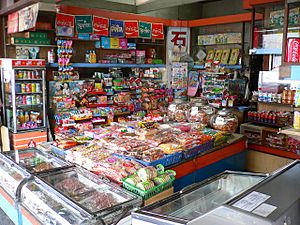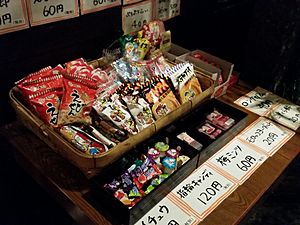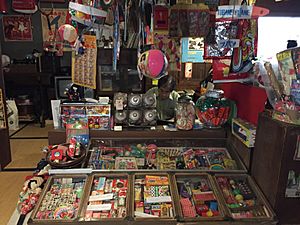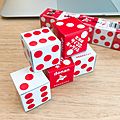Dagashi facts for kids
Dagashi (Japanese: 駄菓子) are super affordable candies and snacks from Japan. You can think of them like "penny candies" in other countries, but with a unique Japanese twist!
The word dagashi comes from two Japanese words: da (meaning "small" or "not important") and kashi (meaning "snacks"). They got this name because they are cheap enough for kids to buy with their pocket money.
Most dagashi come in bright, fun wrappers. Sometimes, they even include a small toy or a chance to win another snack! These toys are often tiny figures, and winning another snack is always a fun surprise.
Long ago, dagashi were mostly sold in special shops called dagashiya. But today, you can find them in many convenience stores too.
Contents
The Story of Dagashi
Even though modern dagashi became popular after World War II, these types of snacks have been around since the Edo period (1603-1868). Back then, dagashi were simple snacks made from things like starch or corn. They were the everyday treats for regular people. More expensive sweets, called jōgashi, were made with fancy white sugar.
Dagashi were most popular in the Shōwa period (from the 1950s to the early 1980s). During this time, dagashiya (the special dagashi shops) were everywhere. They were favorite spots for kids to hang out after school.
Later, around the 1980s, kids started having more pocket money. Many dagashiya began selling other things or were replaced by convenience stores.
Today, you can still find dagashi in some dagashiya, in convenience stores, or even buy them online. Sometimes, Japanese schools or cultural events will even have cool displays of dagashi and old dagashiya shops!
What Makes Dagashi Special?
Companies that make dagashi think about a few key things:
- Low Price: Each snack should cost between 10 and 200 yen. This is a good price for a school kid's allowance.
- Stays Fresh: Dagashi need to last a long time without needing a fridge or air conditioning. This was important for old dagashiya shops, especially in summer.
- Fun for Kids:
* Cool Wrappers: The wrappers and mascots are colorful and easy to spot. This helps kids choose their favorites and remember the brands. * Playful Snacks: Some dagashi are designed to be played with! This makes the small snack last longer and adds to the fun. Examples include Fue Ramune (a candy that works like a whistle) and neri-ame (a syrup you can knead like taffy). * Prizes: Many dagashi come with a chance to win another snack, small figurines, or collectible cards called menko.
Dagashi can be many different kinds of treats. They include hard candies, gum, chocolates, and small cakes. You can also find savory dagashi like juice powders, potato and corn snacks, tiny cups of ramen, rice crackers, flavored squid, and even preserved fruit!
All About Dagashiya

Dagashiya are the traditional shops where dagashi are sold. Besides the snacks, dagashiya often sell small toys. They might also have coin-operated arcade games or gashapon machines (toy capsule machines).
In the past, especially during the Showa period, kids would often stop by a dagashiya after school. It was a place to buy cheap snacks and hang out with friends and the shop owners.
Even though there are fewer dagashiya now because of convenience stores, you can still find them in Japan. There are about 50 in the Tokyo area alone! Today, dagashiya are seen as a bit nostalgic and are often found in places where people go on vacation.
Popular Dagashi Snacks
Here are some well-known types of dagashi:
- Anzu-bō: A stick candy made from dried apricots.
- Baby Star Ramen, Yatta Men, or Ramen Baba: Crispy, flavored fried noodle snacks.
- Big Katsu: A fish snack shaped to look like a fried pork cutlet (tonkatsu).
- Botan Rice Candy: A sweet rice candy wrapped in edible rice paper.
- Butamen: A mini instant cup of ramen noodles.
- Cabbage Taro: A corn snack that tastes like okonomiyaki (a savory Japanese pancake).
- Choco Bat: A chocolate-flavored biscuit shaped like a baseball bat.
- Dice Caramel: Caramels in cube-shaped paper packaging that looks like dice.
- Fugashi: Long, airy strips of dough that are baked and coated in brown sugar.
- Ikasomen: Thin, noodle-like strips of dried squid.
- Kinako-bō: A sweet candy flavored with kinako (roasted soybean flour), often eaten with a toothpick.
- Konpeitō: Traditional, colorful sugar candies.
- Morocco Yogur: A powdered candy that comes in a small plastic yogurt jar. You eat it with a stick.
- Namaiki Beer: A tablet that, when added to water, makes a fizzy juice drink that looks like beer!
- Neri-ame: A flavored syrup that you knead with chopsticks until it becomes like taffy.
- Ninjin: Puffed rice in a tapered bag that looks like a carrot.
- Ramune: A popular Japanese soda.
- Ramune candy: Hard candies that taste like soda or lemonade. They often come in plastic bottles shaped like ramune soda bottles. This includes Fue Ramune (a whistle candy) and Bottle Ramune (powdered candy in an edible wafer bottle).
- Sakura Daikon: A pink slice of fermented daikon radish, colored by ume (plum).
- Sukonbu: Dried kelp (seaweed) flavored with vinegar.
- Tirol Choco: Small, cube-shaped chocolates. Their wrappers sometimes feature Japanese pop culture or anime characters.
- Umaibō: A crunchy, stick-shaped corn snack, similar to Cheetos. They come in over 36 different flavors!
- Ume Jam: A pickled plum soaked in a sour, red sauce, often spread on a milk cracker.
- Yan Yan: A snack with biscuit sticks and a dipping cream.
- Yocchan Ika: Dried squid flavored with soy sauce or vinegar, either whole on a stick or cut into pieces.
- Young Donuts: Miniature sugar donuts.
Images for kids
-
Miyako Kombu, a kind of sukonbu








